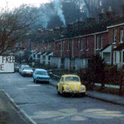The decline of inner city neighbourhoods and overspill council estates around the edges of cities has become a commonplace of public debate ever since the riots of the early 1980s. Britain and other European countries began to look as though they were developing ghettos along US lines. Some neighbourhoods became no-go areas where police seemed powerless to prevent disorder.
These problems have worsened over the past 10 years, but remedies are emerging from close-up studies of the most blighted areas. Rather than arguing about whether or not Britain has an underclass, policy-makers are focusing their attention on what is actually happening in Britain's roughest corners.
There has arguably been more civil turbulence in Britain since 1980 than in any other period this century. Why? In the wake of the slum clearance programmes between the 1930s and the 1970s, employers, landlords and investors abandoned inner cities. Many relocated themselves in suburbs and new towns. They were followed by, and followed, the able-bodied workforce. As a result, unemployment rose disproportionately in poorer, less popular areas. Better-off working class families moved out and new immigrants moved in, competing with those left behind for the worst jobs. In the riot-hit areas of London, Birmingham, Manchester and Liverpool, the situation was in danger of exploding. Between 1990 and 1995 there were 28 serious riots and up to 100 smaller disturbances following the more publicised inner city riots of the 1980s.
It was at this point that the US term "underclass" began to appear in Britain. But the nature of our cities and social traditions makes the term misleading in the British context. In the US, racial ghettos dominate every main city, and whites and blacks are almost completely segregated. In Britain, all-white peripheral council estates of a thousand or more households are often more isolated, poorer and closer to social breakdown than the racially mixed inner cities.
Violence in American cities has always been more extreme than in Britain. In the late 1980s, the murder rate in the US was eight times higher than in Britain; a single riot in Los Angeles in 1992 left 58 people dead, compared with three dead in the 28 British riots of the 1990s. The underclass debate in the US was also set in a context of minimal welfare support for single-parent families and little entitlement for able-bodied unemployed males. The extremes of poverty and decay in American urban ghettos made British inner cities look peaceful and prosperous.
Unlike the US, Britain has a dense population heavily concentrated in large conurbations. It is an old industrial society in which 90 per cent of the population has been urbanised for at least a century. The number of people per square mile is ten times higher in Britain than in the US. Britain's civic traditions, its welfare state and its notion of citizenship have evolved amid closely intertwined wealth and poverty. The rich have not been able to escape the problems of the poor completely. Shortage of land made the creation of dense cities inevitable, and valuable-the hub of growth, invention, interchange and culture.
As rapid urbanisation gave rise to the feckless bottom layer of Victorian cities, so civic reformers built drains, pavements, schools, libraries, hospitals and railways to create a sense of order. The "rabble" were incorporated through education, health and civic provision; they became the most productive workforce in the world. Local leaders emerged from even the most disadvantaged areas.
The critical factor was the reinvestment of wealth, generated by reforming city entrepreneurs, turning disorderly urban growth into a complex web of mutually reinforcing supports. A similar pattern emerged throughout Europe.
Our Victorian past should save us from an American future, but only if we are able to recall some of the lessons from that past. Today, the most pressing problem is polarisation in housing. Until recently, council tenants included many middle-income families. But during the 1980s, the number of home owners rose sharply, accounting for more than two thirds of all households, while the private rented sector shrank to under 10 per cent. The right to buy for council tenants led to the sale of 1.5m popular properties to better-off tenants. Councils and housing associations-which still house about one quarter of the population-have been left with a growing proportion of tenants who are either low paid, jobless, or single parents.
Some 2,000 council estates-representing about one quarter of all council housing-are difficult to manage because of their size, design, repair problems, lettings pattern and history. These estates, housing over 1m households and about 3m people, are mainly spread in and around big cities-London, Birmingham, Manchester, Liverpool, Newcastle, Glasgow, Edinburgh. They house mainly low-income families without work. There are also many popular council estates (maybe two thirds) and many working tenants (about one third). None the less, a majority of council tenants depend mainly on the state for their income. The number of single-parent families in council housing rose from 10 per cent in 1981 to nearly 20 per cent in 1991-three times higher than the national average. In some of the most hard hit estates, one in two families has a single parent.
Crime in these areas is four times higher than the national average. Young people on these estates have a vitality and sense of urgency about life that, if thwarted, finds destructive outlets. Girls can seek solace and status in motherhood and home making-still recognised social roles. But boys find outlets in disruptive behaviour, negative social attitudes-often rejecting work and education.
Ofsted, the new government inspectorate for schools, has conducted surveys showing that the poorer the children, the worse they are likely to do at school. The proportion of children achieving five or more GCSEs, grades A to C, at 16 is directly related to the proportion of children qualifying for free school meals. Schools with less than one in ten free school meals have a 60 per cent success rate; schools with two thirds free school meals achieve an 18 per cent success rate. Exam failure rates in secondary schools linked to unpopular estates are five times higher than the national average. Truancy rates are four times higher.
These estates have come to house heavy concentrations of young, poorly educated, unemployed men who have no stake or recognised role in their communities. Many of them see no harm in stealing cars, attacking the police, intimidating older residents or forming gangs to claim control of the streets.
In a recent report by myself and Rebecca Tunstall (Dangerous Disorders: Riots and Violent Disturbances in 13 Areas of Britain 1991-92) we found that 12 of the 13 main riots between 1991 and 1992 took place on large council estates outside London. All the riot areas except one had traditional houses with gardens; only one area had a high number of ethnic minority residents. The majority of rioters were white British-born males between 10 and 30, and the riot estates were almost all on the edge of cities, not in inner city areas.
But some marginal council estates at the bottom of the heap have fared better over the past 15 to 20 years than expected. These estates are more successful and popular now than in 1980, when their problems were first recorded. Many of them consist of densely built flats housing multiracial communities in inner cities.
On estates where there has been a proper civic response-direct intervention to buttress the already existing supports, control bad behaviour and keep local services in place-improvements have been marked. On these estates poverty and unemployment did not go away, but the estates became better places to live in.
We can replicate these results without significant extra public spending or institution building-using the money and the people within our existing social support systems. But we must be prepared to reorganise our sometimes clumsy civic organisations-something which the new government seems ready to do.
What exactly needs to be done? Between 1980 and 1995, 20 of the most unpopular estates in Britain experimented with localised housing management, tenant involvement, beat policing, resident initiatives, local repairs, security and environmental care. This did not eradicate social stigma or counter economic depression, but it did lead to a change in atmosphere. Whereas previously tenants had been unable to communicate with decision-makers, and failed to make inroads on the simplest of problems, they now had constant access to an estate-based office with familiar staff whose role was to take immediate action. Previously, staff rarely ventured on to the estates for which they were responsible; now repairs teams, caretakers, cleaners and managers were based on the estates. Previously, empty units often took months to relet, leading to vandal damage, loss of rent and a "no-go" image. But with a local office and local lettings, it became possible to fill properties quickly and attract more applicants. Most importantly, local lettings generated sufficient extra income to cover the cost of additional staff. Every ten units let paid for two locally based workers.
The impact of localised policing was also significant. Whereas the estates became markedly poorer between 1980 and 1995, with far higher levels of single-parent families and economic inactivity than the national average, their crime rate stabilised or shrank compared with national and local trends. Why? Because of the presence of more locally based staff for tenants to contact when trouble arose; more local street activity deterring criminals; better police-community links; more youth initiatives; less empty and unattended property; quicker responses to problems; direct communication resulting in more trust, confidence and enthusiasm.
If half of the rent income for an estate went into running the local housing service, each estate of 1,000 units could have at least 20 locally based housing, support and repair workers. Many estates have none. Yet remote, centralised services do not reduce the threat of disorder; they damage the threads weaving local areas together. Conversely, placing services on estates max- imises contact and control, involving people directly, and often creating significant cost savings. If the model was replicated across large, unpopular urban estates, the new government could save billions of pounds currently spent on dealing with crime and violence. It is the lesson our Victorian forefathers learnt-re-investing in chaotic cities pays handsomely.












